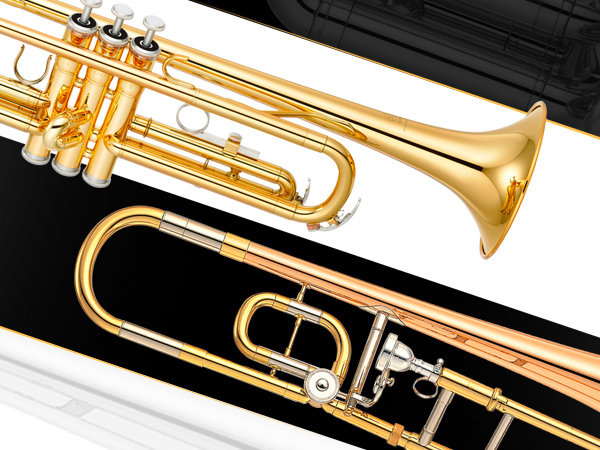What’s the Difference Between Alto, Tenor and Bass Trombones?
This is what makes each instrument special.
Trombones are one of the more interesting and unique instruments that you’ll see anywhere. Unlike saxophones, pianos, guitars or virtually any other musical instrument, trombones have no reeds, keys or strings. With trombones, it’s all about moving their long slides.
That said, like trumpets, cornets and other brass instruments, the sound that trombones make is largely dependent upon the intricate tubing that comprises the horn. Also significant to the instrument’s sound is its bell size and the shape of its bore (interior chamber). In this article, we’ll explore the things that differentiate the three most popular types of trombones: alto, tenor and bass. But before we do, let’s talk about some of their history and commonalities.
Origins of the Trombone
Originally developed in the mid-15th century, trombones have changed rather significantly over time. Until the 18th century, the instrument was called a “saqueboute” (in French) or a “sackbut” (in English). Some sources suggest the name comes from the French “sacquer,” which means “to draw out” (as in a sword from its sheath).
The current name simply means “large trumpet.” In German, it’s called a “posaune,” which was also an early term for trumpet. The two horns are relatives and share the same early predecessor. Throughout history, the trombone has been used in many different musical settings, from concert halls to churches to basement jazz clubs, though when it first rose to popularity, it was primarily found in the courts of aristocrats and used by military bands. Beethoven is credited as the first composer to use trombones in a secular symphony (in 1808). Today, the trombone is a mainstay of myriad musical genres, from classical to jazz, marching bands to Afrobeat.
Similarities
The three most popular types of trombones in use today — alto, tenor and bass — were all designed to mimic the range of the human voice. (There are also higher range soprano trombones, but they are less common). As mentioned previously, with trombones, it’s all about the slide; moving it serves to lengthen or shorten the tube, thus changing the note. (The tightness of the players’ lips in the mouthpiece — the embouchure — also has an effect on pitch, though it’s more subtle).
While each of these three trombones look much the same and act in a similar fashion, there are some significant differences too. Let’s take a closer look.
Alto Trombone
Alto trombones are somewhat less popular than their tenor and bass counterparts; for the most part, they are employed to perform the symphonies of yesteryear with historical accuracy.
As the name would suggest, alto trombones play higher notes than tenor or bass models. To accomplish this, their bodies, bells and bores are smaller. And because they (and their slides) are shorter, the slide positions used to make notes are also different from other types of trombones. Alto trombones are pitched in the key of E-flat.

Tenor Trombone
The most common type of trombone is the tenor — so much so that it’s considered the “standard” trombone. Tenor trombones are tuned in B-flat and have a characteristic piercing, bright sound that pokes through in even the densest musical sections. This makes them perfect for large jazz ensembles where the playing involves strident accents and raucous solos, as opposed to the more subtle demands of classical music.
That’s also why tenor trombones are often a staple of marching bands, though in recent years there has been a trend to replace them with baritone horns, which are more maneuverable (since they don’t have slides, less space is needed between players) and can be easier for young students to learn.

Tenor trombones are sometimes made with F-attachments (sometimes called F-triggers.) These are levers that increase the inner length of the instrument’s tubing, allowing players to more easily play lower notes, with decreased wind resistance and without the time and effort it takes to extend the slide all the way out. Yamaha offers several tenor trombone models with this feature.

Bass Trombone
To the untrained eye and ear, tenor and bass trombones are essentially the same instrument. They look similar and are the same size in terms of total length (both are 2.7 meters); in addition, both are tuned to B-flat, and their lowest and highest notes are the same.
However, there are two important differences, the most significant of which is their bore size (the diameter of the interior tubing that blossoms up to the bell of the horn). Bass trombones feature a wider bore than tenor trombones, making it easier to to play low notes. In addition, they have a bigger bell. For these reasons, bass trombones produce a lower, mellower tone than tenor trombones. As a result, they are more often employed in orchestras than jazz ensembles and are typically used to play classical music instead of jazz.

Valve Trombone
A variation on the tenor trombone is the valve trombone, first developed in the early 19th century, around the same time that valves were first incorporated on the trumpet. Instead of a slide, valve trombones use a series of three piston valves (similar to those on trumpets) to change pitch. This makes it easier for student trumpeters and euphonium players to learn and also makes fast, difficult passages easier to perform. As a bonus, valve trombones match visually with standard tenor trombones since they have the same type of bell, mouthpiece and overall length. The tradeoff, however, is that they have a slightly less “open” tone than traditional slide trombones.

Interestingly, a hybrid instrument called the “Superbone” was developed in the 1980s for legendary trombonist Maynard Ferguson. This was a combination valve and slide trombone that had both a complete valve section and a working slide. The Superbone can be played as a slide trombone, a valve trombone, or in combination; alternative slide positions are available when valves are depressed.
Trombone Mouthpieces
One final note: When it comes to trombones, not all mouthpieces are equal. Generally, larger trombones require larger mouthpieces. If the bore of an instrument is wider, then the shank or “arm” of the mouthpiece must be larger as well … and so must be the cup of the mouthpiece, where players put their tightened lips. Conversely, the smaller the trombone, the narrower or smaller the mouthpiece. For more information about brass mouthpieces, check out this blog posting.
Yamaha offers a wide variety of alto, tenor, bass and valve trombones. Click here for more information.














